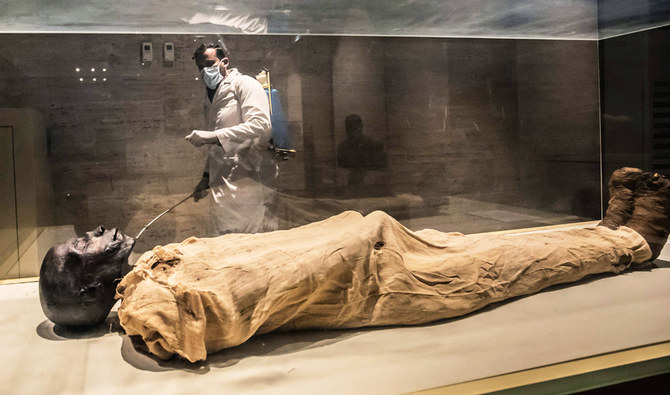Egypt prepares to transport royal mummies to Fustat Museum
- They are accompanied by 17 royal coffins and the procession will move from Tahrir Square to the Nile Corniche
CAIRO: Egypt is preparing for a royal procession of mummies from the Egyptian Museum in Tahrir Square to the National Museum of Egyptian Civilization in Fustat.
The procession features 22 mummies, 18 of which are mummies of kings and four are of queens.
Head of the Museums' Sector at Egypt's Supreme Council of Antiquities, Moamen Othman, said the transfer was being carried out in line with specific procedures and international safety measures.
The artifacts were placed in sterilization units equipped with the latest scientific equipment and loaded onto carts that were specially designed and equipped for the purpose, he explained. The aim was to preserve the integrity of the mummies and ensure that the celebration was carried out in line with the greatness of ancient Egyptian civilization.
The Minister of Tourism and Antiquities Khaled Al-Anani and top museum officials have been discussing the final preparations for receiving the royal mummies.
The royal mummies being transferred are: King Ramses II, Ramses III, Ramses IV, Ramses V, Ramses VI, Ramses IX, Thutmose II, Thutmose I, Thutmose III, Thutmose IV, Seqnen Ra, Hatshepsut Amenhotep the First, Amenhotep II, Amenhotep the Third, Ahmose Nefertari, Merit Amon, Siptah, Merenptah, Queen T, Seti I, Seti II.
They are accompanied by 17 royal coffins and the procession will move from Tahrir Square to the Nile Corniche.
The Cairo governorate declared a state of emergency to determine the path of royal mummies and the area being developed in the vicinity of the Museum of Civilizations in Ain Sira, which will receive the royal mummies.
The area directly in front of the museum was converted into a tourist attraction project linked to the museum, and there are several roads serving the area and linking it to main roads.
The event is scheduled to start with the opening of the Egyptian Museum's door for the mummies' exit, in the presence of international ambassadors and the media.
The mummies will move from the Egyptian Museum on 22 old Egyptian-style cars, with musical instruments playing and horses.
Sources said the event had been rehearsed for more than two weeks to finalize it and that tests were being carried out on lighting, decorations and equipment.
The sources added that work in the Egyptian Museum was taking place around the clock, with an exchange between archaeologists and inspectors.
It is expected that the National Museum of Egyptian Civilization will be one of the most important tourist attractions in the country.
It is located near the Babylon Fortress and overlooks Ain Al Sira in the heart of the historic city of Fustat.
The foundation stone for the museum was laid in 2002.
It will be one of the most important and largest archeology museums in the world and also the first to be dedicated to the entirety of Egyptian civilization, with more than 50,000 artifacts from the earliest times until the modern era.

No comments:
Post a Comment